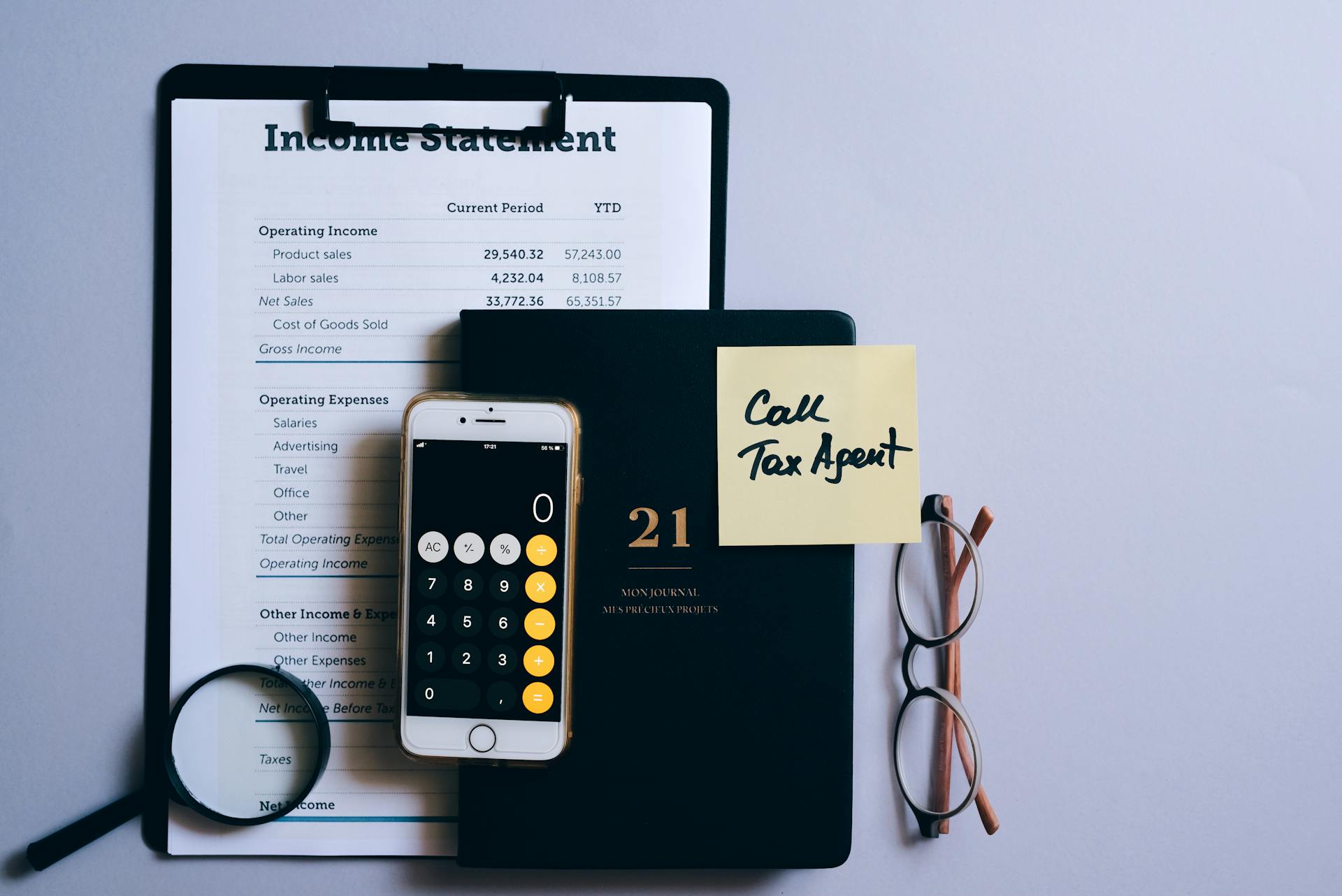
Debt reduction is a process of paying off debts with a lower interest rate by consolidating or refinancing existing debts. This can be done through debt consolidation loans, balance transfer credit cards, or debt management plans.
The best method for debt reduction depends on individual circumstances, but debt consolidation loans often have lower interest rates than credit cards. For example, a debt consolidation loan with a 6% interest rate can save you money compared to a credit card with a 20% interest rate.
Debt management plans, on the other hand, involve working with a credit counselor to create a plan to pay off debts over time. This can be a good option for those who struggle with budgeting or need help negotiating with creditors.
By paying off high-interest debts first, you can free up more money in your budget to tackle lower-interest debts.
You might enjoy: Credit Counseling Debt Management Plan
Debt Reduction Methods
Debt reduction methods can be a game-changer for those struggling with debt. You need a solid plan to tackle your debt, and there are two popular methods to consider: the snowball method and the avalanche method.
Consider reading: Avalanche Debt Method Pdf
The snowball method is all about enjoying those little wins. By paying off smaller debts first, you'll get a sense of accomplishment and motivation to keep going.
To make the snowball method work, you need to stay focused on your end goal. This means not adding new debts while you're working on paying off your existing ones.
The avalanche method is a more analytical approach. If you have larger balances with higher interest rates, this method may be the way to go. It may take longer to roll over to your next account, but it should save you money in the long run.
To use the avalanche method effectively, you need to track your spending and stick to your budget. This will help you avoid charging up additional debts while you're working on paying off your existing ones.
Here are the key differences between the two methods:
Who Should Consider
If you're struggling to pay off debt, debt settlement might be a good option for you. You should consider debt settlement if you have significant unsecured debt, such as credit card debt or personal loans.
If this caught your attention, see: Debt Settlement
Having trouble making minimum payments on your debts is a clear sign that you need help. If your credit score is dropping due to missed or late payments, debt settlement can help you get back on track.
High interest rates or fees can make your debt grow exponentially, making it harder to pay off. If your total debt is more than half of your gross income, debt settlement can provide relief.
A financial crisis, such as job loss or unexpected medical expenses, can make it difficult to pay bills. If you're receiving calls from creditors or collection agencies, debt settlement can help you negotiate a settlement.
To qualify for debt settlement, you'll need to meet certain requirements. You'll need to have at least $7,500 in unsecured debt, for example.
Here are some key factors to consider when deciding if debt settlement is right for you:
- You have significant unsecured debt
- You're consistently struggling to make minimum payments
- Your credit score is dropping due to missed or late payments
- Your debt is growing due to high interest rates or fees
- Your total debt is more than half of your gross income
- You're facing a financial crisis
- You're receiving calls from creditors or collection agencies
- You can afford the monthly deposit to build up money to settle the debt
- You've tried to negotiate directly with creditors on your own without success
Alternatives to Debt Reduction
If you're struggling to pay off debt, you might be wondering if there are alternative solutions to debt reduction. One option is debt consolidation, which can simplify your payments by combining multiple debts into one loan with a lower interest rate.
Debt consolidation can save you money on interest and make it easier to manage your debt. For example, if you have three credit cards with balances of $1,000, $2,000, and $3,000, and interest rates of 18%, 20%, and 22%, consolidating them into one loan with an interest rate of 12% could save you hundreds of dollars in interest over time.
Another option is debt management plans, which can provide temporary relief from creditors and help you pay off debt over time. These plans are typically offered by non-profit credit counseling agencies and can be a good option for those who are struggling to make payments.
Debt management plans can help you reduce your monthly payments and interest rates, and may even eliminate some of your debt. For instance, a debt management plan might reduce your monthly payment from $500 to $300 and lower your interest rate from 18% to 6%.
Negotiating with creditors directly can also be an effective alternative to debt reduction. By contacting your creditors and explaining your situation, you may be able to work out a temporary reduction in payments or a lower interest rate.
Negotiating with creditors can be a good option if you're experiencing a temporary financial setback, such as a job loss or medical emergency. This can give you some breathing room to get back on your feet and make payments again.
Readers also liked: What Is Considered Good Debt
Debt Management Plans
A debt management plan is a structured repayment program that can help you tackle your debts more effectively. These plans are offered by nonprofit credit counseling agencies and are designed to create a customized payment strategy based on your financial situation.
You'll work with a certified credit counselor who will assess your finances, negotiate with creditors to get you lower interest rates or waived fees, and set up a schedule for making a single monthly payment to the agency. This payment is then distributed among your creditors.
A debt management plan can simplify your payments by consolidating multiple debts into one, potentially reducing your interest rates, and saving you money on fees. However, you'll typically need to pay a setup fee ranging from $30 to $50 and a monthly maintenance fee of around $20 to $75.
You'll also need to close your credit cards to avoid taking on more debt, and some creditors may not agree to the terms of the plan, so you'll need to continue making your regular payments to them. Missing payments can knock you out of the plan, and it's essential to pick an agency accredited by the National Foundation for Credit Counseling or the Financial Counseling Association of America.
Debt management plans don't affect your credit scores, but closing accounts can hurt your scores. Once you've completed the plan, you can apply for credit again. It's crucial to understand the fees and alternatives you may have for dealing with debt before committing to a plan.
Consider reading: Why Credit Card Debts Are Called Unsecured Debt
Bankruptcy Options
Bankruptcy options can provide a fresh start for individuals overwhelmed by debt. There are two main types of bankruptcies: Chapter 7 and Chapter 13.
Chapter 7 bankruptcy can erase most credit card debt, unsecured personal loans, and medical debt in just three or four months. However, it won't erase child support obligations and will hurt your credit scores, staying on your credit report for up to 10 years.
If you have used a co-signer, your bankruptcy filing will make that co-signer solely responsible for the debt. Additionally, you can't file another Chapter 7 bankruptcy for eight years if debts continue to pile up.
Chapter 13 bankruptcy, on the other hand, is a three- or five-year court-approved repayment plan based on your income and debts. If you stick with the plan, the remaining unsecured debt is discharged, and you get to keep your property.
Here's a quick comparison of Chapter 7 and Chapter 13 bankruptcies:
Bankruptcy
Bankruptcy is a complex and often misunderstood process, but understanding the basics can help you make informed decisions about your financial future. Bankruptcy is a legal process that can either clear out most of your debts or help you create a plan to pay them off over time.
There are two main types of bankruptcies: Chapter 7 and Chapter 13. Chapter 7 bankruptcy can erase most credit card debt, unsecured personal loans, and medical debt, but it won't erase child support obligations. You'll also hurt your credit scores, which can stay on your credit report for up to 10 years.
Chapter 7 bankruptcy typically takes three or four months to complete, but it may not be the right option if you have property you want to keep, as the rules vary by state. You may be able to keep certain kinds of property, such as vehicles up to a certain value and part of the equity in your home.
Related reading: Chapter 13 and Car Loans
If you don't qualify for Chapter 7, you may need to file for Chapter 13 bankruptcy. This involves creating a three- or five-year court-approved repayment plan based on your income and debts. If you stick with the plan, the remaining unsecured debt is discharged, and you'll get to keep your property.
Here's a quick comparison of Chapter 7 and Chapter 13:
It's essential to remember that bankruptcy has long-term effects on your credit score, making it difficult to get loans in the future. However, if your credit is already damaged, a bankruptcy may allow you to rebuild much sooner than if you keep struggling with repayment.
A Risky Option
Debt settlement is a last resort for those who face overwhelming debt but cannot qualify for bankruptcy or don't want to file bankruptcy.
Typically, debt settlement companies ask you to stop making debt payments when you enroll in a settlement plan and instead put the money in an escrow account.
Each creditor is approached as the money accumulates in your account and you fall further behind on payments.
Fear of getting nothing at all may motivate the creditor to accept a smaller lump-sum offer and agree not to pursue you for the debt.
Do-It-Yourself Debt Reduction
You can tackle debt on your own with a combination of debt consolidation, creditor negotiations, credit counseling, and stricter budgeting.
You can contact your creditors, explain your situation, and ask for concessions to catch up on payments. Most credit card companies have hardship programs that may lower your interest rates and waive fees.
Debt settlement can be negotiated on your own, saving you money on fees and giving you control over the timeline.
Gather as much money as you can to make a lump-sum offer to your creditors. This might mean taking a part-time job, selling valuable belongings, or other quick ways to get cash.
If your debt isn't too large, you can explore standard debt-payoff strategies like balance transfer credit cards or debt consolidation loans with lower interest rates.
A 0% balance transfer credit card can be a good option, allowing you to move your debt to a card with a 0% introductory APR and make faster progress on paying off your debt.
Take a look at this: Does Interest Accrue after Brankruptcy
Debt consolidation loans with lower interest rates can also be a viable option, as long as you make the payments by the end of the promotional period to avoid hurting your credit score.
You can get a 0% balance transfer credit card if you have a good credit score, allowing you to move your debt to a card with a 0% introductory APR.
Debt Reduction Programs
Debt reduction programs can help you manage your debt and get back on track. Many credit card issuers offer hardship programs to lower interest rates, waive fees, or reduce monthly payments for a set period of time.
These programs are usually temporary, lasting six months to a year, and are best used before you fall too far behind on payments. If you're already missing payments, you may be better off going through a credit card debt relief program.
A debt management plan allows you to pay your unsecured debts in full, often at a reduced interest rate or with fees waived. You make a single payment each month to a credit counseling agency, which distributes it among your creditors.
If this caught your attention, see: Debt Reduction Programs Legitimate
Debt management plans do not affect your credit scores, but closing accounts can hurt your scores. Once you've completed the plan, you can apply for credit again.
It takes a combination of several factors for a debt-relief program to be successful, including choosing a reputable service and committing to the program. Abandoning your debt-relief payment plan mid-way through can lead to bigger penalties than you did at the start.
The best solution is based on the severity of your situation. For someone who simply wants to reduce their debt expenses, a consolidation loan or balance transfer card could offer relief in the form of lower interest charges.
Having a lot of debt can be overwhelming, but it's still critical to take the time to consider the details of different solutions so you understand any potential risks. Credit card debt can be managed through do-it-yourself debt management, including forbearance, interest rate reduction, debt consolidation, workout arrangement, or settlement agreement.
Expand your knowledge: Education Debt Reduction Program Va
Choosing a Debt Reduction Company
Choosing a debt reduction company can be a daunting task, but it's essential to find a reputable one to help you manage your debt. Research reputable companies that hold outside accreditations, such as from the American Association for Debt Resolution.
Before selecting a company, check with the Better Business Bureau to see if there's a history of complaints. This will give you an idea of the company's reliability and customer service.
You should also look for companies that are accredited by the National Foundation for Credit Counseling or the Financial Counseling Association of America. These organizations have strict standards for their member agencies.
Debt reduction companies shouldn't advise you to stop communicating with your creditors. They can't stop debt collection calls or lawsuits until the debt is settled.
Be wary of companies that try to collect an upfront settlement fee or guarantee a reduction amount. This is a red flag, and you should avoid working with them.
It's also essential to understand the fees, terms of service, and how long it will take to settle your debts. A reputable company should be upfront about this information.
Understanding Debt Reduction
Debt reduction is a process that can help you get back on your feet financially. It involves changing the terms or amount of your debt to make it more manageable.
There are several debt reduction options available, including debt management plans and debt settlement. These options can help you negotiate with creditors to settle your debt for less than the full amount owed.
A debt management plan allows you to pay your unsecured debts, such as credit cards, in full, but often at a reduced interest rate or with fees waived. You make a single payment each month to a credit counseling agency, which distributes it among your creditors.
Debt settlement, on the other hand, is the process of negotiating down a debt to a lower amount than you owe. This can be a huge relief, but the process can take up to three to four years, and it isn’t always successful.
It's essential to pick an agency accredited by the National Foundation for Credit Counseling or the Financial Counseling Association of America if you choose a debt management plan. This ensures that you're working with a reputable organization.
Here are some key differences between debt management plans and debt settlement:
Missing payments can knock you out of a debt management plan, so it's crucial to stay on top of your payments. Once you've completed the plan, you can apply for credit again, but closing accounts can hurt your credit scores.
See what others are reading: Debt Reduction Plans
Frequently Asked Questions
What are the disadvantages of a debt relief program?
Debt relief programs come with potential drawbacks, including high fees and the risk of damaging your credit score. Additionally, these programs may not always lead to debt elimination, and in some cases, can even increase your debt burden
What happens when you use debt relief?
When you use debt relief, your debt is reduced or restructured to make payments more manageable, giving you a fresh start. This can involve forgiving debt, lowering interest rates, or spreading payments over a longer period.
Sources
- https://www.wellsfargo.com/goals-credit/smarter-credit/manage-your-debt/snowball-vs-avalanche-paydown/
- https://money.com/what-is-debt-relief/
- https://www.nerdwallet.com/article/finance/find-debt-relief
- https://www.debt.org/advice/relief-options/how-does-debt-relief-work/
- https://www.nerdwallet.com/article/loans/personal-loans/how-does-debt-settlement-work
Featured Images: pexels.com


